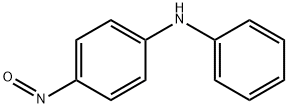Chemical Properties
TKB is a black powder or a green plate-like
material with a bluish luster.
Chemical Properties
dark blue to black powder
Uses
4-?Nitrosodiphenylamine is used in organic synthesis such as in the preparation of 1-(Phenylamino)pseudo-mauveine water soluble dye. Potential mutagenic compound.Environmental toxin on US EPA Toxic Release Inventory list (TRI) list.
Uses
Has been used as retardant in vulcanizing rubber.
Definition
ChEBI: Para-Nitrosodiphenylamine is a member of benzenes.
Synthesis Reference(s)
The Journal of Organic Chemistry, 32, p. 153, 1967
DOI: 10.1021/jo01277a038
General Description
Green plates with bluish luster or a black powder.
Air & Water Reactions
Insoluble in water.
Reactivity Profile
4-NITROSODIPHENYLAMINE neutralizes acids in exothermic reactions to form salts plus water. May be incompatible with isocyanates, halogenated organics, peroxides, phenols (acidic), epoxides, anhydrides, and acid halides. May generate hydrogen, a flammable gas, in combination with strong reducing agents such as hydrides. May react with strong oxidizing agents .
Hazard
Questionable carcinogen.
Fire Hazard
Flash point data for 4-NITROSODIPHENYLAMINE are not available; however, 4-NITROSODIPHENYLAMINE is probably combustible.
Safety Profile
Poison by intravenous
route. Suspected carcinogen with
experimental carcinogenic and
neoplastigenic data. Moderately toxic by
ingestion. Mutation data reported. An eye
irritant. When heated to decomposition it
emits toxic fumes of NOx. See also NNITROSO
COMPOUNDS and AMINES.
Potential Exposure
Used as a chemical intermediate for
dyes and pharmaceuticals; in making monomers; and vulcanizing
rubber.
Shipping
UN2811 Toxic solids, organic, n.o.s., Hazard
Class: 6.1; Labels: 6.1-Poisonous materials, Technical
Name Required. UN3077 Environmentally hazardous
substances, solid, n.o.s., Hazard Class: 9; Labels:
9-Miscellaneous hazardous material, Technical Name
Required.
Purification Methods
The amine forms dark green crystals from EtOH or *C6H6 (m 143o). It has UV at max 421nm (EtOH) and is used for detecting Pd and Rh. It is highly toxic and a possible carcinogen.[Beilstein 12 H 207, 12 II 122, 12 III 347, 12 IV 1860..]
Incompatibilities
Nitrated organics range from slight to
strong oxidizing agents. If mixed with reducing agents,
including hydrides, sulfides and nitrides, they may begin a
vigorous reaction. Reaction with aliphatic amines can
release carcinogenic nitrosamines. Incompatible with
oxidizers (chlorates, nitrates, peroxides, permanganates,
perchlorates, chlorine, bromine, fluorine, etc.); contact may
cause fires or explosions. Keep away from alkaline
materials, strong bases, strong acids, oxoacids, epoxides.
4-nitrosodiphenylamine neutralizes acids in exothermic
reactions to form salts plus water. May be incompatible
with isocyanates, halogenated organics, peroxides, phenols
(acidic), epoxides, anhydrides, and acid halides. May generate
hydrogen, a flammable gas, in combination with
strong reducing agents such as hydrideds and active metals.
May react with strong oxidizing agents.


